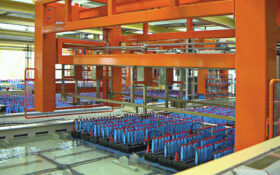The battery industry has joined forces to oppose the inclusion of lead on a list by European Chemicals Agency (ECHA) that could see its use in batteries banned.
ECHA— an agency of the European Union— plans to include lead metal on its eleventh recommendation for substances to be included in the REACH Authorisation List.
Inclusion on the Authorisation List will mean lead is eventually substituted in battery manufacturing and can only be used through granting of specific permission from the EU Commission while the ban is being implemented.
A consortium of 90 companies is calling on ECHA, the European Commission and Member States to halt the proposed REACH Authorisation process that threatens a range of EU industries including lead battery manufacturers.
They believe including lead will add “significant bureaucracy” but bring little in terms of further protecting health and the environment due to the existence of long-standing risk-management measures that already limit risks presented by lead exposure.
A three-month consultation has begun, with ECHA inviting comments on the proposal before 2 May.
The Authorisation List aims to minimise risks related to substances of very high concern (SVHC), by ensuring they are properly controlled throughout their life cycle and finding a substitute for the SVHC, where technically and economically feasible alternatives are available.
The three-phase Authorisation process includes: adding substance to SVHC candidate list (Phase 1); recommendation for inclusion in the Authorisation List (Phase 2); and application for authorisation (Phase 3).
Business rally against proposal
Businesses warn the move could damage essential sectors including those producing energy storage solutions and delivering a circular economy in recycled metals and materials.
The industry consortium is seeking more proportionate regulatory measures to protect important European value chains.
The companies warn that EU “Green Deal” carbon reduction plans could be knocked off course if regulators include lead to the list of substances requiring authorisation to be used.
In a position paper the International Lead Association highlights how the lead value chain is already highly regulated, with some of the world’s most stringent rules protecting health and the environment already resulting in substitution where alternatives that meet end-users’ technical needs exist.
Dr Steve Binks, ILA’s regulatory affairs director, said: “We believe this is a disproportionate approach, given that ECHA itself states that lead and lead compounds are already covered by an extensive body of existing EU legislation.
“That’s why we’re arguing for more proportionate risk management measures. We’ll be making this case in the ECHA consultation.
“And many downstream users of lead – important industries from battery manufacturers to other metals recyclers – will be responding to the EU Commission’s consultation pointing to the highly damaging economic and social implications of including lead in the REACH authorisation process.”
Dr Inge Maes, chair of the lead (Pb) REACH Consortium and sustainability director at non-ferrous metals supplier Aurubis Beerse, said: “The problem with the REACH Authorisation process is that it is a blunt and bureaucratic tool that would adversely impact a broad range of essential industries that are delivering services and products that are supporting EU Green Deal objectives such as reducing climate change and enhancing circularity.
“This makes no sense as, according to EU data, REACH Authorisation would add little to the protection of health and the environment – the remaining major sources of lead emissions in the EU are not in even scope of REACH Authorisation, and risk to workers is currently being addressed by the Commission through a strengthening of existing EU workplace standards”.
Key enabler to clean energy
Batteries have been identified as one of the key enablers to meet future clean energy storage demand.
Industry leaders are concerned that EU decarbonisation targets included in the Fit for 55 package— to reduce greenhouse gas emissions by 55% by 2030— will be impossible to meet if regulators target lead, the core material used in millions of new batteries.
Lead batteries are used in applications including motor vehicles, trains, battery electric vehicles, back-up for uninterruptible power supplies and grid energy storage.
As well as batteries, lead is a vital raw material in other significant industries supporting Green Deal objectives including:
- Cables for renewable energy linking wind farms to the grid
- Solar panel systems
- Enabling recycling of other metals and transition technology elements
The industry consortium has produced a series of factsheets detailing the key role lead plays in Europe.
The European lead usage resource, Lead Matters highlights lead’s role in battery manufacturing, aviation, precision engineering, renewable energy and space.












